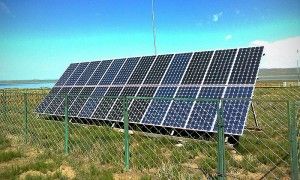Solar Industry Would Fade w/o Incentives
by CalWatchdog Staff | March 9, 2011 9:33 am
 [1]MAR. 9, 2011
[1]MAR. 9, 2011
By KATY GRIMES
The California Solar Initiative Program[2] has spent $2.1 billion in only three years. But three large utility companies and one contractor say is not enough to meet the Legislature’s solar power goal within the 10-year timeframe.
Using ratepayer funds, the solar initiative[3], a solar rebate program, was launched in 2007 with a total funding promise of $3.3 billion. The goal was to install 3,000 megawatts of new solar power in California during the next 10 years.
The solar rebate program is “for customers of the largest investor-owned utilities, Pacific Gas and Electric, Southern California Edison, and San Diego Gas & Electric,” according to the California Public Utilities Commission. Through the CPUC, $2.1 billion has been provided to nonprofit organizations, public agencies, homeowners and businesses to install solar technology — all of it paid for by ratepayers.
The three utilities chosen for the solar initiative have megawatt goals divided among them according to their electricity sales: PG&E 43.7 percent, Southern California Edison 46 percent and San Diego Gas & Electric 10.3 percent through the California Center Sustainable Energy, a nonprofit organization “that helps residents, businesses and public agencies save energy, reduce grid demand and generate their own power through a variety of rebate, technical assistance and education programs.”
In a presentation on Monday from the California Public Utility Commission about the status of the state’s solar initiative, legislators on the Assembly Committee on Utilities and Commerce were presented with a glaring problem: The mandate for the California Solar Initiative is costing more to equip affordable housing projects and commercial projects than initially planned for.
Four Program Components
Molly Sterkel, a Supervisor with the CPUC, explained that the solar initiative program has four program components, each with its own program administrator, as well as the 10-year budget:
- * The research and development program, which provides grants to solar technologies has a budget of $50 million.
- * The Single-family Solar Affordable Solar Housing (SASH) program[4], which provides solar incentives to single family low-income housing and has a budget of $108 million.
- * The Multifamily Affordable Solar Housing (MASH) program[5], which also provides solar incentives to multifamily low-income housing. It has a budget of $108 million.
- * The Solar Water Heating Pilot Program (SWHPP)[6], which provides solar hot water incentives to residences and businesses in San Diego only, and is administered through California Center for sustainable Energy.
But it’s the affordable housing component of the solar program that seems to be over budget. To date, Sterkel said that only 331 affordable housing homes have been outfitted with solar roofs, and 36 multi-family affordable housing projects, but the total cost was not given.
“Why are the numbers and percentages so low?” asked Assemblyman Roger Hernandez, D-Baldwin Park. “The numbers are so de minimis that it doesn’t even show up on the radar.”
Sterkel said, “It’s a really new concept bringing solar into low income communities.”
I contacted the CPUC to discuss why affordable housing solar costs more, and for future projections, but did not get a return call.
At the hearing, Sterkel said that in addition to the CPUC’s solar initiative program, the Legislature expected that the State of California would also have other programs to support onsite solar projects besides the solar initiative, including the California Energy Commission’s New Solar Homes Partnership as part of the total “Go Solar” program with the solar initiative.
Committee Chairman Steven Bradford, D-Inglewood, called the numbers Sterkel shared “dismal, based on the amount of investment.”
PG&E director David Rubin told the committee that PG&E has paid out more than $950 million of financial incentives to solar customers, and called the program “very successful.”
However, Rubin also said that the utility has run out of money in the non-residential incentive program promoting rooftop solar systems, and wants “additional money to be added for the shortfall.” If additional funds are not added, Rubin said that the projects reserved for funding “may not make it all the way” before other projects on the list get funded. He also said PG&E may need to restrict additional payments made to the non-residential projects, to adjust for the shortfall.
Alternatives
Other options being considered by PG&E to cover the shortfall are rate increases, or possibly moving some of the research and development money to incentives.
However, Sterkel later clarified for the legislators that the total number of solar systems installed to date through the program is 45,000, which does not include the 331 low-income housing projects.
Southern California Edison presented a similar picture to PG&E’s shortfall situation. Gary Barsley, a manager with SCE, said the utility will not achieve the projected solar projects because they are spending money “at a faster rate than expected.”
But Barsley also said, the incentives decline as the life of the project continues, making it more expensive in the up-front investment.
Southern California Edison has 16,000 customers in the program, 15,000 of which are residential.
Both utilities said that government programs receive a higher priority on the project list than non-governmental programs.
The California Center for Sustainable Energy (CCSE) states that its solar initiative program for the San Diego Gas & Electric company is currently operating with a $32 million shortfall, similar to the other utilities. Interestingly, the CCSE is a non-profit organization which receives federal stimulus money through the American Recovery and Reinvestment Act (ARRA) and other government subsidies, according to its most recent annual report[7].
At the end of his testimony, Barsley added, “The solar industry is not ready to exist without incentives.”
- [Image]: http://www.calwatchdog.com/wp-content/uploads/2011/03/Solar-Panels-Wikipedia.jpg
- California Solar Initiative Program: http://www.cpuc.ca.gov/puc/energy/solar/aboutsolar.htm
- solar initiative: http://www.cpuc.ca.gov/puc/energy/solar/aboutsolar.htm
- Single-family Solar Affordable Solar Housing (SASH) program: http://www.cpuc.ca.gov/PUC/energy/Solar/sash.htm
- Multifamily Affordable Solar Housing (MASH) program: http://www.cpuc.ca.gov/PUC/energy/Solar/mash.htm
- Solar Water Heating Pilot Program (SWHPP): http://www.cpuc.ca.gov/PUC/energy/Solar/swh.htm
- annual report: https://energycenter.org/index.php/incentive-programs/self-generation-incentive-program/sgip-documents/cat_view/227-annual-reports?orderby=dmdate_published&ascdesc=DESC
Source URL: https://calwatchdog.com/2011/03/09/solar-industry-cant-survive-without-incentives/